Freesia flowers are herbaceous plants grown for their intense fragrance and pure colors. Native to Africa, these low-growing springtime flowers spring up from a solid bulb known as a corm. Discover the best freesia flower varieties and learn how to grow and care for them with this easy guide.
Freesia first sends up a tuft of narrow leaves that can reach 12” in length and then blooms into a one-sided spike of fragrant flowers, each consisting of 6 to 8 tepals.
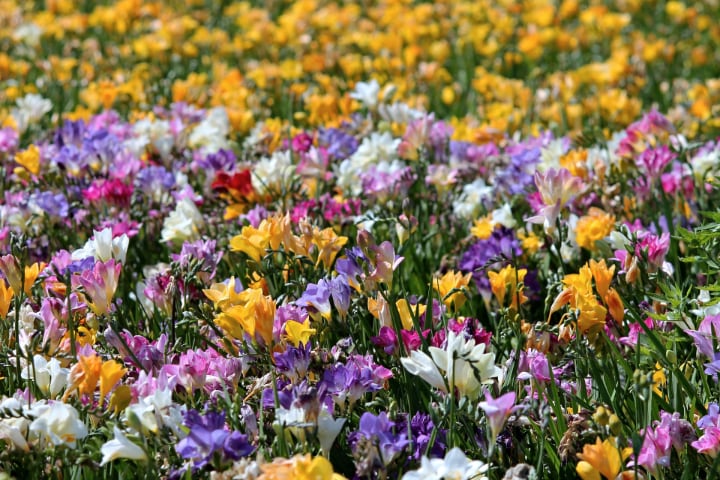
Freesias stay fresh for a fairly long time after being cut and can last for around 3 weeks in a vase, which is why they’re often used for flower arrangements.
The flower’s distinctive look makes it a welcome presence in any house or garden.
How to Grow Freesias
Growing freesias in the garden or indoors isn’t all that difficult. You just need to consider your climate and plant them at the right time. Follow our tips for outdoor and indoor planting.
How to Plant Freesias in the Garden
The best time to plant freesias in the garden is during early fall. The important thing is to choose a sunny spot.
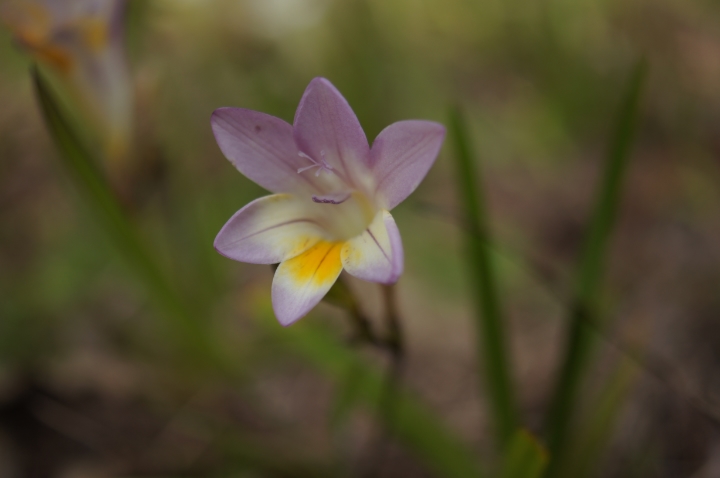
Step 1 – Choose a Sunny Spot
Freesias need sun to grow healthy and put on nice blooms. More about light requirements in the section below on freesia plant care.
Step 2 – Plant the Corms
Plant the bulbs two inches deep and at a slightly wider distance between them and with the pointy bit up. You may want to group your freesias in bunches of seven to create a rich effect.
Step 3 – Water and Add Mulch
When you’re done, water well and cover the ground around them with a layer of mulch.
Step 4 – Use a Support
Consider using a support system for the stems, as these are light and may not always be able to bear the weight of varieties that produce many flowers.
Step 5 – Trim the Foliage
After your freesias bloom in the spring, trim the foliage but don’t discard them as they will enter dormancy.
Step 6 – Remove the Corms from the Earth
Since these flowers are not cold hardy, it’s usually best to remove the corms from the earth after the leaves fall. Cut back the stems and allow the corms to dry, before cleaning them of any shriveled portions.
Step 7 – Replant the Corms in Spring
Store the corms them in a cool, dry place safe from frost, preferably in sand or peat so you can plant them again in spring.
Here are some bulbs you can grab to start growing this plant your garden.
How to Grow Freesia from Seed
While this flower tends to grow best from corms, you can also grow it from seed. Here are the key steps you want to follow.
- Let the seed pods ripen on the plant after blooming, which usually happens in the summer.
- Once they are brown and have formed vertical lines or striations, collect the seed.
- Dry the seeds in a paper bag for a few days and then sieve them, picking out the bigger seeds.
- Before planting the seeds in spring, soak them for a day in warm water.
- Sow the seed in trays with compost and keep the tray moist. The seeds should sprout after about a month.
- Don’t move the seedlings into a pot until after they grow true leaves.
- After moving to pots, keep them outdoors between 55-65°F (13-18°C) before planting them in the garden.
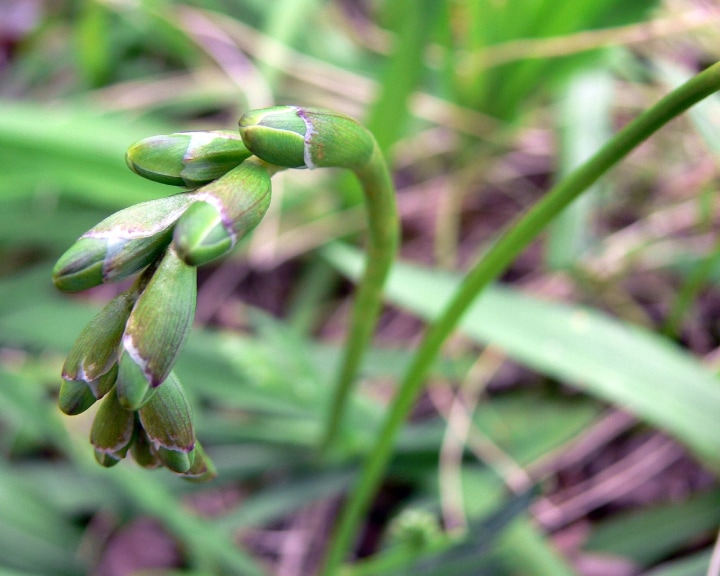
If you choose to grow this flower from seeds, here are some seed packs that can help you get started.
How to Grow Freesias in a Pot
You can grow freesia flowers in a pot without much trouble. Plant the bulbs in early spring in an outdoor container.
Or you can plant them in the fall if you live in a warmer zone, provided that you make sure that they go dormant in winter.
You can do this by keeping them in a cooler area around 40°F (5°C)—but safe from freezing temperatures! If you pot in spring, choose bulbs that have undergone dormancy.
Important: Use a shallow pot that’s at least three times the height of the corm.
Start by filling your pot with a mix of two-parts compost and one-part grit. As noted already, these plants aren’t very demanding in terms of the soil.
But make sure that the container you use has good drainage—make some extra holes in the bottom if needed. You can also use pebbles to facilitate drainage.
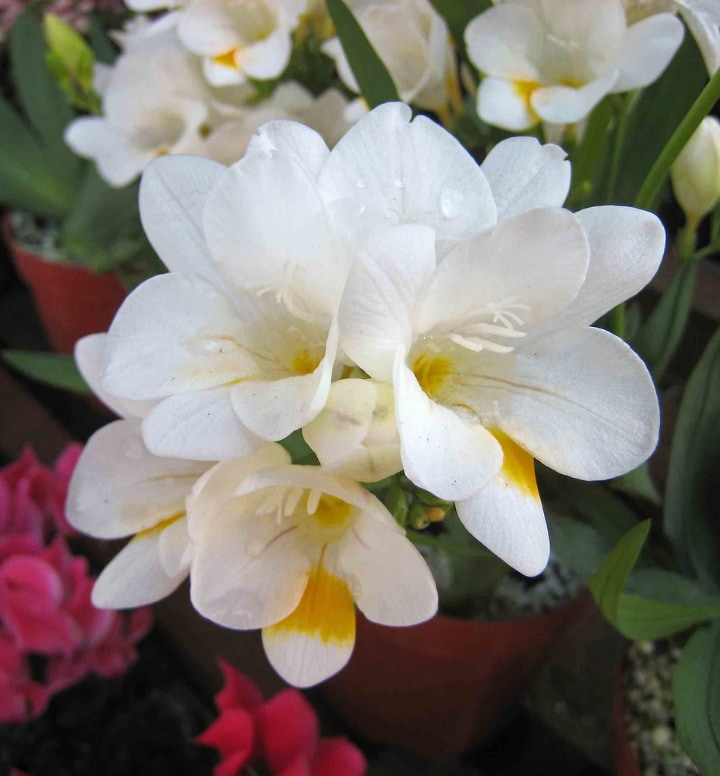
Next, follow the same instructions for garden plating with the note that adding mulch to the pot is not necessary.
Tip: Don’t press the corms into the potting mix—let them loose so they can spread their roots.
Keep the pot in a shaded, cool place such as the garage until the corms sprout. You can then move it in a sunny window and keep watering it.
Ideally, you don’t want to bring it indoors until after the buds begin to show color.
Good to Know
- Your potted freesia needs sunshine to stay healthy during the growth period.
- Most varieties will take at least 100 days after planting to flower.
- Use cane supports or similar to help ease the weight of the flowers off the stems.
- After blooming, keep your flower in a bright spot but avoid direct exposure to sunlight to make the blooms last longer.
- Freesias don’t usually bloom again in the same pot, so remove the new corms and repot them following the same instructions.
Freesia Care Tips
The following general freesia care tips can help you create ideal conditions for your flower. But keep in mind that each variety may have specific requirements. Always check the labels!
Soil
Outdoors, freesias tend to grow best in sandy or stony soils.
Planting them in fertile soil rich in organic matter is ideal and will spare you the trouble of fertilizing them too often. Coastal freesia flowers such as the Alba can grow in damp soil as well.
We’ve written a whole guide on soil types, so make sure you check it out.
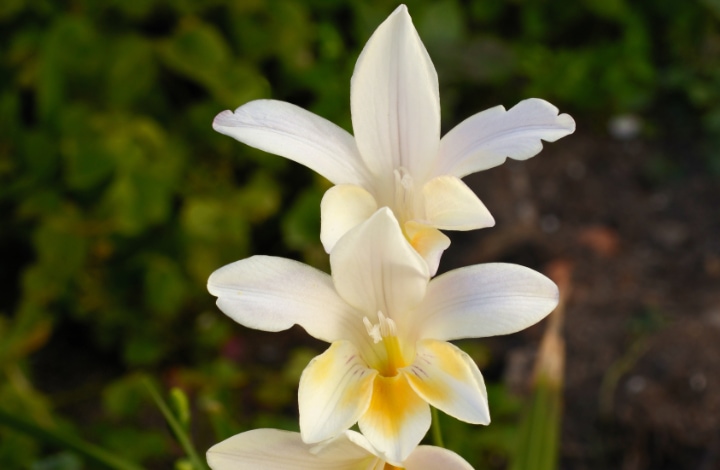
If you’re growing these flowers in a pot, you can use a regular potting mix. Whether you grow them outside or inside, ensure proper drainage through the use of peat moss or compost.
Light
Freesias like the sun and tend to grow best in full sun to light shade. Some varieties like the sun more than others, so again, it’s important to check the instructions that come with your plant—or just ask the seller.
Tip: As a general rule, you don’t want to plant freesias behind walls or trees that rob them of daylight.
Temperature
These plants are susceptible to temperature variations—they’re not cold hardy. They will not survive the winter if the temperature drops below freezing.
They need minimum winter temperatures well above 20-25°F (3.9-6.7°C) to come back in the spring.
But bear in mind that after planting in the fall, freesias need temperatures around 50-55°F (10-12.8°C) at night to form bulbs.
Depending on your location, you may have to dig up the bulbs in the fall, move them in a container to an unheated garage or another cold place, and replant them in the spring.
Tip: Indoors, freesias usually do best in temperatures around 60-70°F (16-21°C).
Watering
These flowers are not very demanding when it comes to watering. While the plant is putting out new sprouts, it’s best to keep the soil moist.
When your freesias are flowering, watering them once a week should be enough in most climates.
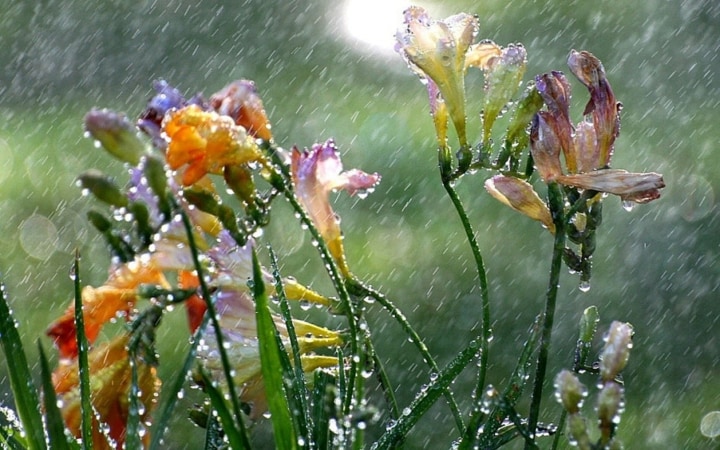
Freesias like 50% humidity, meaning that in a dry climate you’d have to water them more. Except for some coastal varieties, these flowers don’t like soggy ground!
Fertilizer
Apply a high-potassium or balanced fertilizer when the first sprouts emerge every two weeks. You can fertilize again when the first buds appear.
Freesias don’t need much fertilizing if you plant them in good soil, and especially if you add compost.
Types of Freesia Flowers
Now that you know how to grow and care for these flowers, let’s look at some of the freesia varieties you can grow in your garden or home.
Including as many as 16 species, these flowers come in many different varieties, some more colorful than others.
Discover now some of the most beautiful and fragrant types of freesia flowers you can plant and grow.
1. Speedy White
Some freesias grow faster than others, and Speedy White is one of them—the name kinda gives it away, doesn’t it?
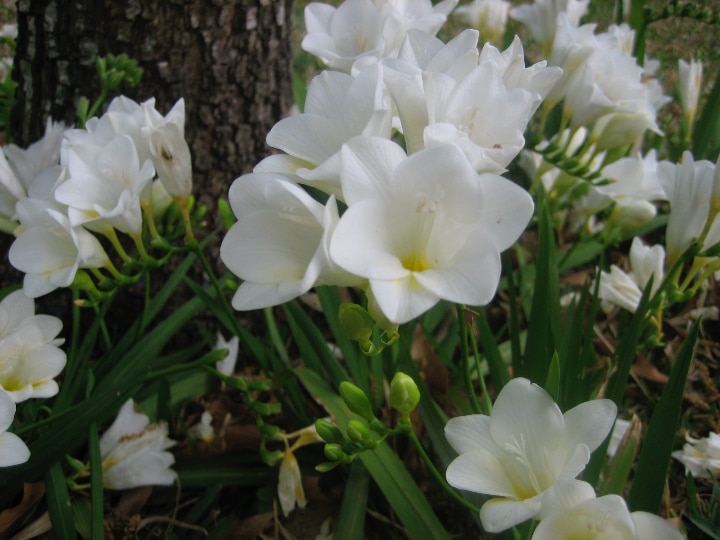
Elegant and delicate, this flower wears bright white petals around contrasting small yellow centers. It looks great anywhere you put it.
2. Algarve
This variety wears light shades of blue and quiet whites. It may look a bit purple at the fringes.
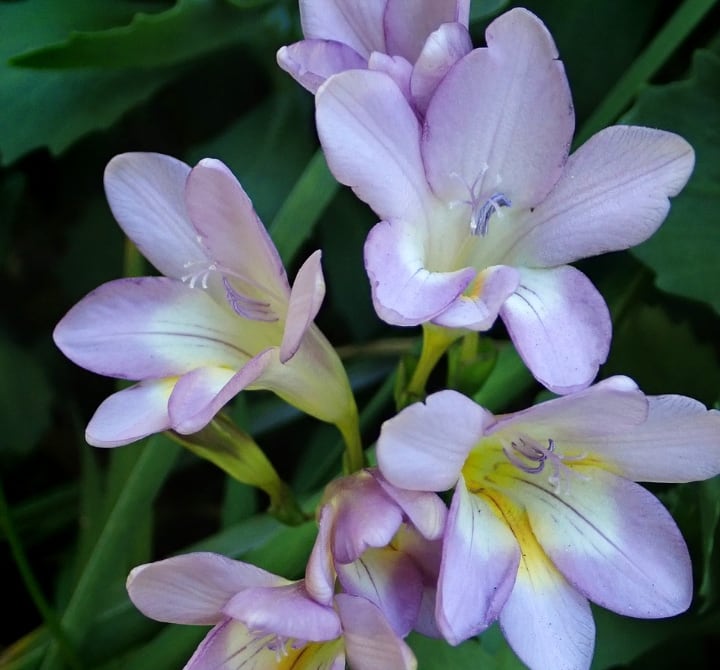
It’s one of the most delicately beautiful freesias for containers and borders.
3. Golden Passion
Wearing rich yellow flowers, this one grows up to 10 flowers on a single stem, which is more than most other varieties.
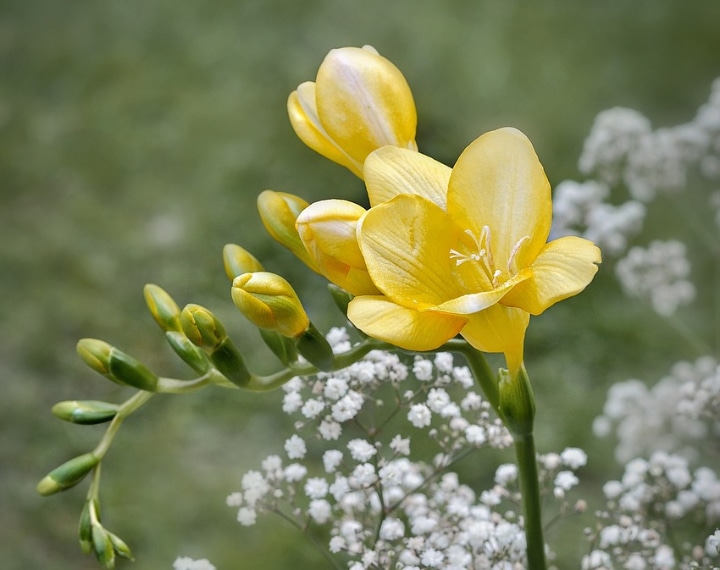
Needles to say, it makes for a striking sight in any garden or container.
4. Oberon
With its veined, yellow petals tinged with red, the Oberon is an instant hit with many flower lovers.
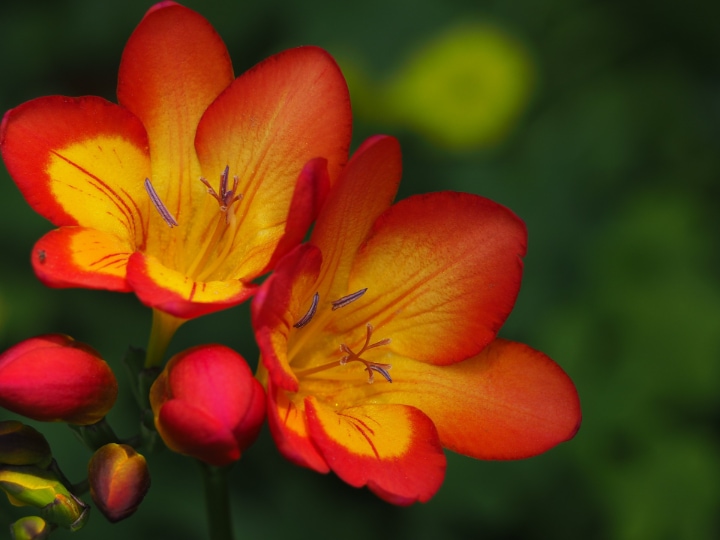
Tip: If you plant it in your garden, make sure to protect it from frostbite—low temperatures can easily damage it.
5. Pink Attraction
The pale pink to deep pink petals of this freesia curl beautifully around each other, making for a rich, multilayered flower.
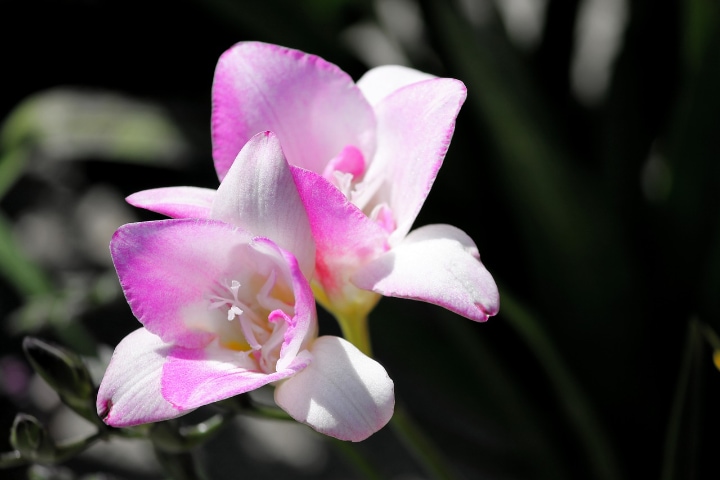
It’s one of the most delightful pink varieties you can find.
6. Honeymoon
Daintily mixing blush pink with delicate white hues, and wearing bright leaves proudly, this one is perfect for engagements and weddings.
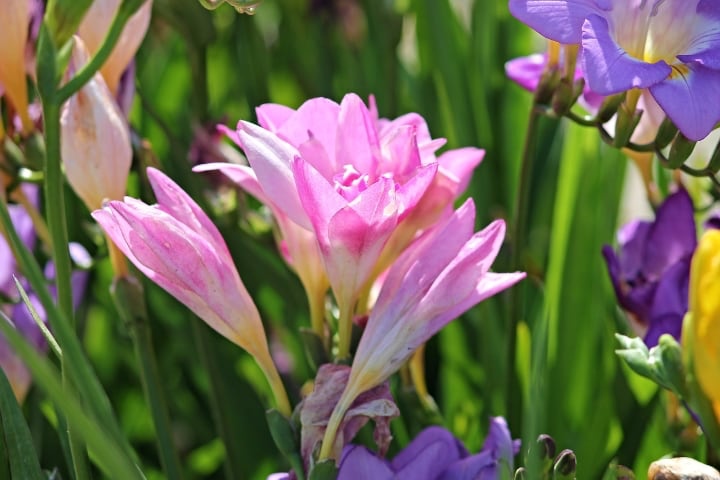
You must have seen it already in at least one flower arrangement, even if you may not have known it by its name. It looks wonderful in a vase, too!
7. Corvette
Stoop a little to smell a clump of Corvette freesias and their subtle, wonderful scent will make you want to take them home with you.

This variety has large white petals in a layer-like arrangement. It grows pretty fast, too.
8. Vienna
The creamy-white Vienna freesias are easy to grow and maintain. You can use them as border plants either on their own or in combination with more vividly-colored flowers.
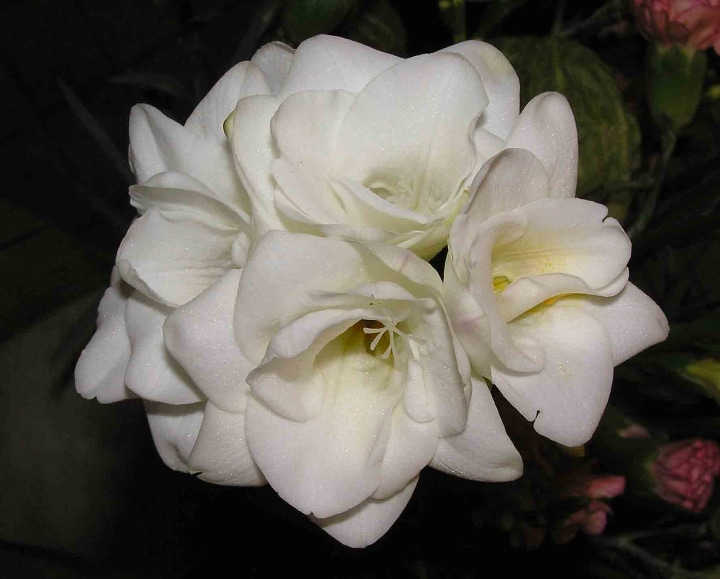
You’ll love their big flower heads and the yellow blush in their centers.
9. Joan Evans
This white variety wears raspberry fingerprint-like markings on its three lower petals, giving it an unmistakably look.
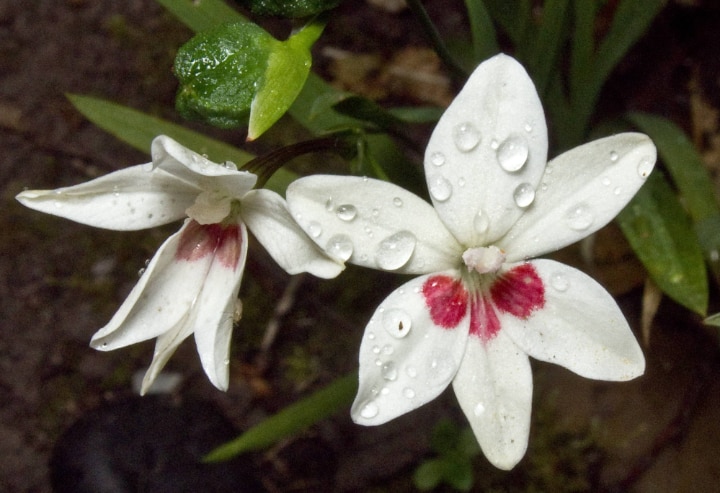
It’s as if a mischievous painter dipped her fingers in some color and pressed them on the white petals when no one was looking.
10. Alba
One of the most beautiful white varieties, at least according to us, Alba grows up to 18”.
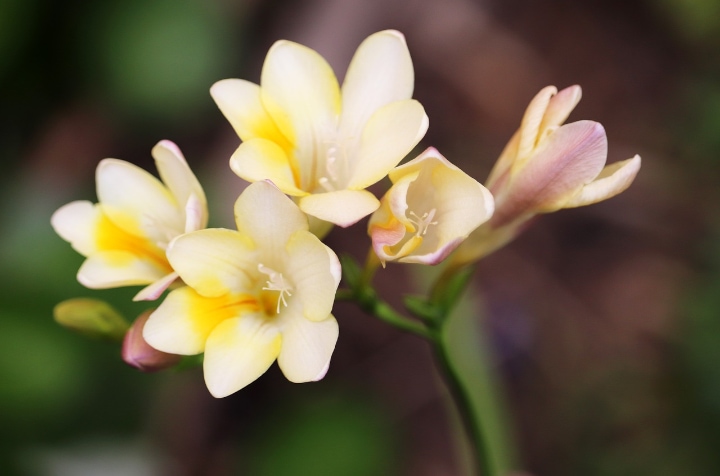
You’ll love its yellow accents and, if you live in a cold region, its hardiness compared to other varieties. It can grow in coastal regions, too.
11. Ambassador
Known for its large white blooms, Ambassador freesias are ideal when combined with brightly colored flowers in bouquets or arrangements.
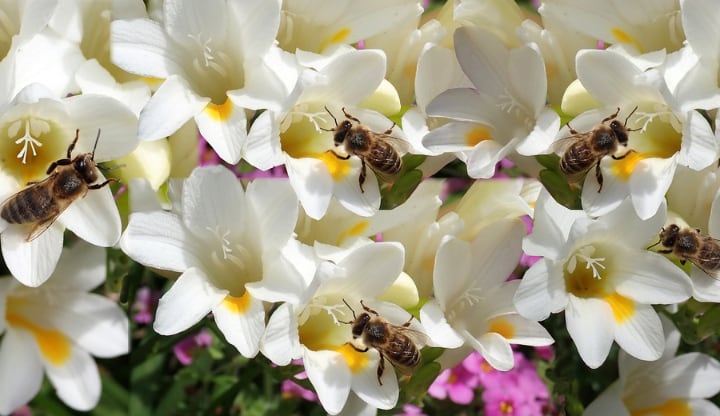
Tip: They tend to grow taller than most other freesias, so you can use them as midground or even background plants in your garden.
12. Virginia
This all-white flower is the epitome of purity and innocence. Just look at the image below and you’ll see what we mean.
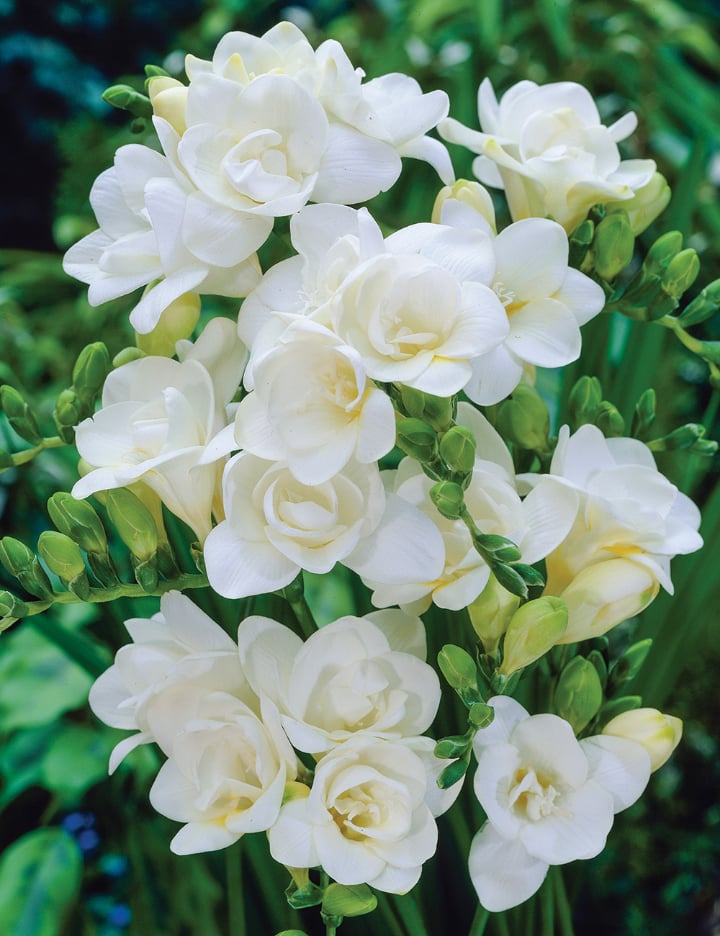
In addition to its bright petals, it also carries a wonderful fragrance, a scent to make other flowers envious.
13. Ballerina
A marvelous flower for bouquets and table arrangements, the Ballerina is a creamy-white freesia with dense petals.
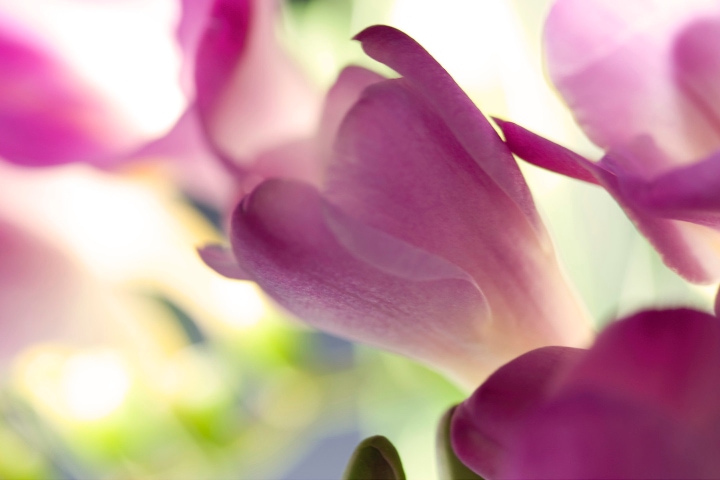
A summer flower, it gladdens every year not just many eyes, but also many nostrils.
14. Purple Rain
With its vividly colored double tepals and yellow-green center, Purple Rain is hard to pass by.
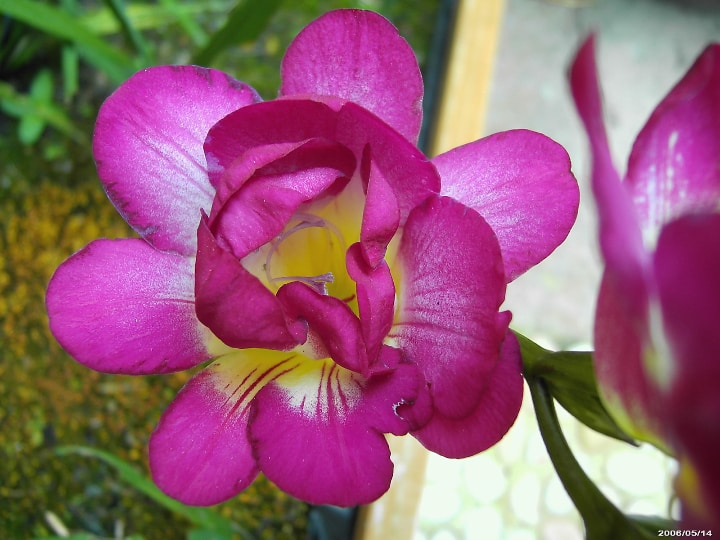
If you’re looking for a vibrant flower to grow in a pot or container, this variety can be an inspired choice.
15. Troubadour
Troubadour freesias come with a rich yellow core like a summer sun that radiates into a reddish-pink flower.
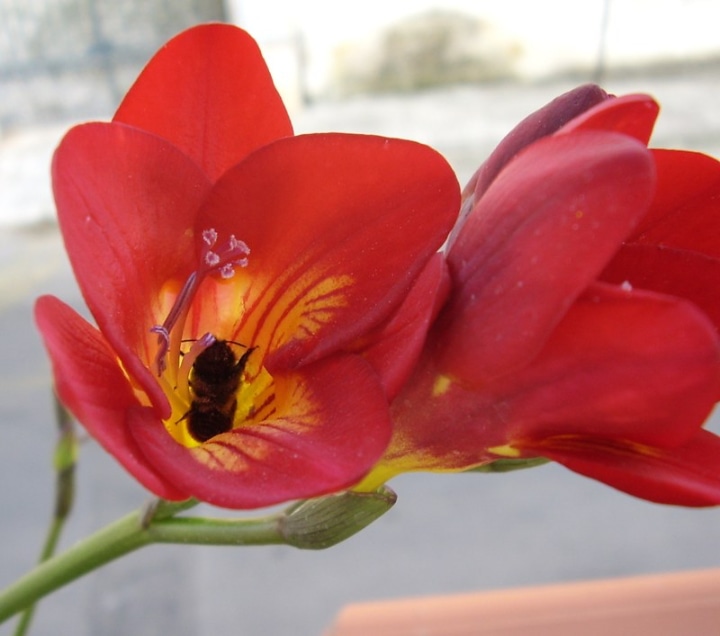
A decidedly romantic choice, it’s more than suitable for giving to a partner or loved one.
16. Double Volcano
Ignite more than feelings of friendship with this intensely colored flower. You can find both all-red Double Volcano freesias and red variants with bright orange-yellow centers.
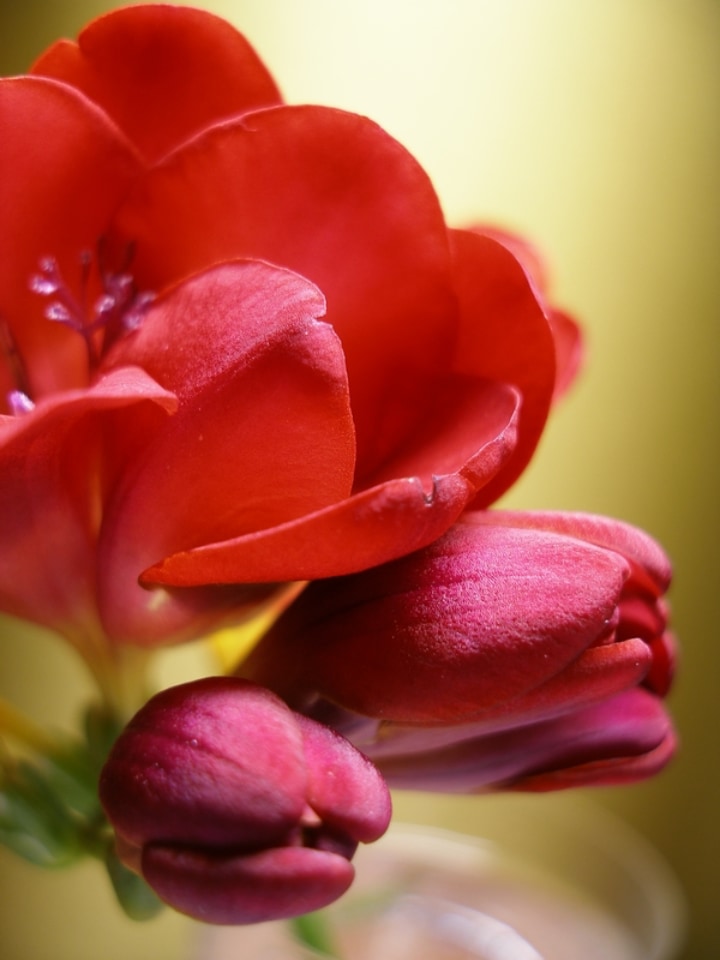
Tip: Look for double-flowered cultivars for a terrific addition to your house or garden.
17. Cote d’Azur
Wearing shades of lavender and violet and a few tasteful touches of white, Cote d’Azur is one of the more exotic-looking varieties on our list.
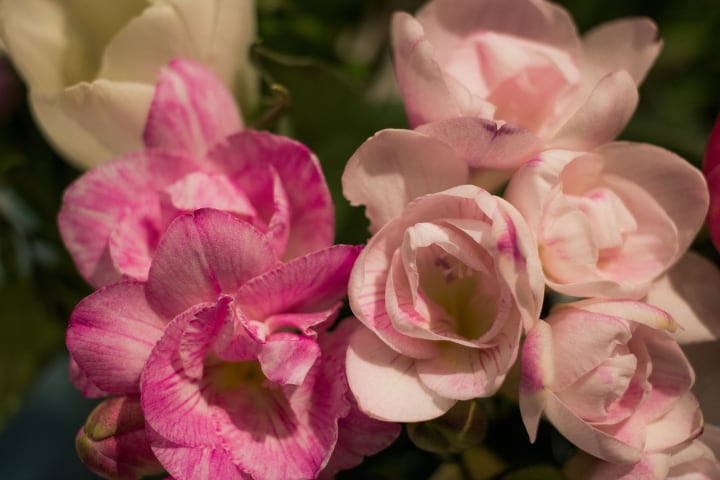
It prefers full sun to partial shade and can grow taller than most other cultivars.
18. Blue Bayou
The Blue Bayou has blooms that grow very close together, made up of violet-blue double-tepals that are often tinged with white.
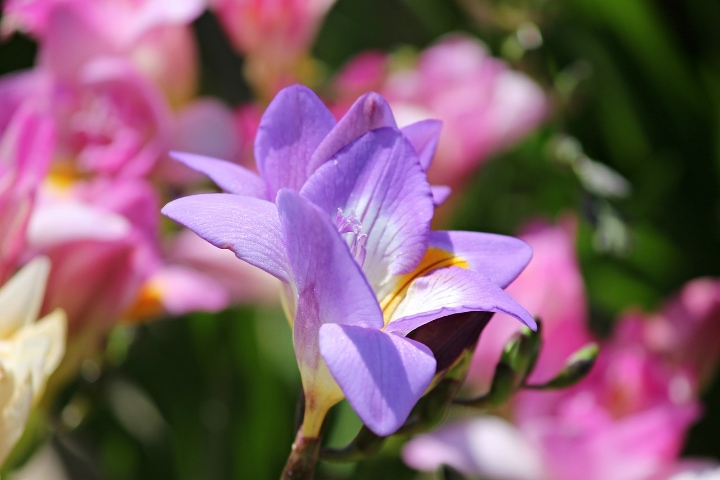
A relatively modern invention, this hybrid variety is richly scented.
19. Lady Brunet
Of all types of freesias, the dark orange Lady Brunet looks the most like a rose. But then it doesn’t have any thorns!
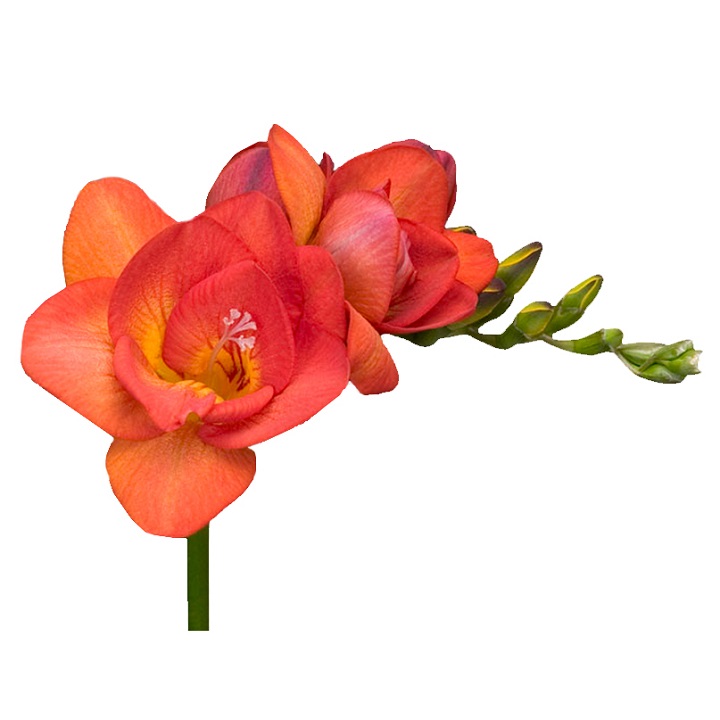
Because the buds grow so close together, from a distance it may look as if this flower has just one huge bloom.
The Meaning of Freesia Flowers
In case you’re wondering where the name comes from, this plant was named after German botanist Friedrich H.T. Freese.
Freesias symbolize trust, friendship, purity, innocence, thoughtfulness, and sweetness.
Depending on who you give them to, your gesture can convey that you have complete trust in that person or that your feelings for them are sincere.
Because of their symbolism, these flowers are appropriate gifts for both friends and partners.
And because they also symbolize purity and innocence, they are popular flowers to give as a gift to someone who’s just had a child.
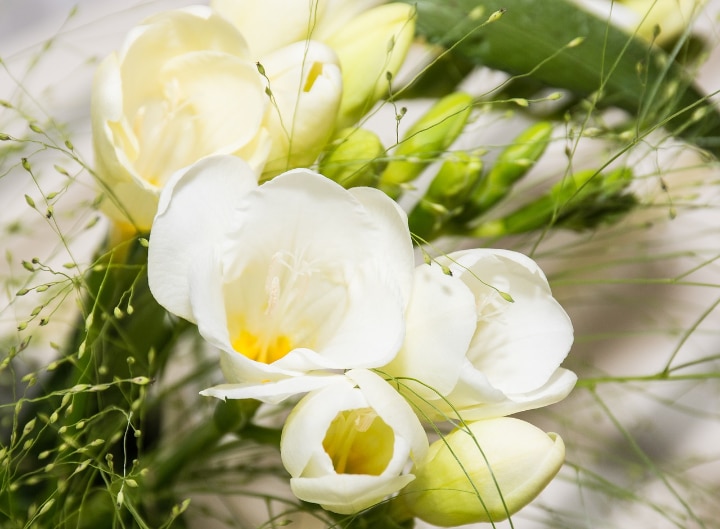
Freesias are commonly used as decorations during baptism celebrations and as wedding flowers, not least because of their fragrance.
During Victorian times, this was the flower of trust. It was common for people to give freesia flowers to each other, regardless of their gender or the nature of their relationship.
It was a way for them to prove their friendly devotion and loyalty to each other. Today, these flowers still carry some of that symbolism.
The Meaning of Freesia Colors
We’ve looked already at the general meanings of this plant. But each freesia color comes with its own meanings. Let’s explore the most important of them.
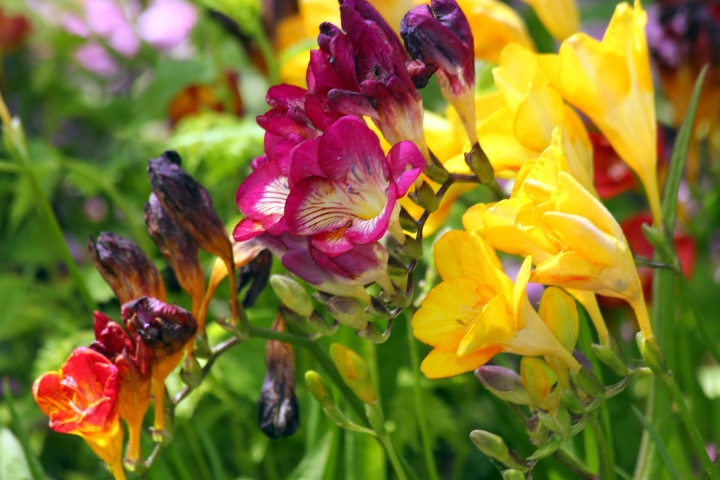
- White freesias symbolize innocence and purity, making them a popular choice for weddings and new births.
- Yellow freesias stand for friendship, which makes them perfect gifts for dear friends.
- Purple freesias symbolize royalty and beauty—of all types of freesias they tend to be the rarest.
- Red freesias stand for love and passion more than other colors, making them an apt choice for lovers who are also best friends.
Frequently Asked Questions About Freesia Flowers
Gardeners love this flower and tend to ask quite a few question about this flower. We’ve put together the most common questions we’ve heard in this section. We hope you’ll find the answers useful!
Does freesia bloom more than once?
Outdoor freesias can bloom again in the spring or fall, depending on when you plant them, provided that night temperatures are cool enough for them to enter dormancy. But bear in mind that frost will kill most varieties.
Is freesia a perennial?
Freesia bulbs are perennials. In native regions where weather conditions trigger dormancy and protect them from frost, this flower is a perennial.
But if you live in a colder region, it may behave more like an annual in that you have to replant the bulbs for the flower to bloom again.
Do freesias spread?
Freesias best spread by new corms or offsets of mother bulbs. In some cases, they may also spread from self-seeding, but the characteristics of the plant may differ from the parent plant and the resulting growth may be weaker by comparison. Learn more about how to grow freesias.
What does freesia smell like?
Freesia has a sweet and fruity smell that can be either intense or subtle, depending on the cultivar you choose. You can even say that this flower smells a bit like candy. White and yellow varieties tend to carry the richest fragrance.
Ready to Plant a Freesia?
We’ve seen that freesias are the flowers of friendship. So why don’t you befriend some of them?
Whether you plant them in a pot or step out into your garden and make room for them there, freesias could become your new favorite flower.
With their wonderful fragrance, pure colors, and effortless grace, these flowers can be any gardener’s delight.
And they’re not that pretentious to grow either so you really have no excuse not to grow your own. Get started now!
PS: If you enjoyed this post, share it with your gardening friends. Help us spread the word about this lovely flower!

Your website looks interesting with a lot of plant information
Thank you, Catherine! Hope to see you soon again:)